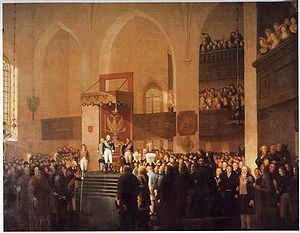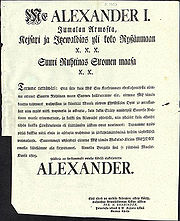
Diet of Porvoo
Encyclopedia

Diet (assembly)
In politics, a diet is a formal deliberative assembly. The term is mainly used historically for the Imperial Diet, the general assembly of the Imperial Estates of the Holy Roman Empire, and for the legislative bodies of certain countries.-Etymology:...
to establish the Grand Principality of Finland in 1809 and the heir of the powers of the Swedish Riksdag of the Estates
Riksdag of the Estates
The Riksdag of the Estates , was the name used for the Estates of the Swedish realm when they were assembled. Until its dissolution in 1866, the institution was the highest authority in Sweden next to the King...
. The session of the Diet lasted from January to July 1809.

Finnish War
The Finnish War was fought between Sweden and the Russian Empire from February 1808 to September 1809. As a result of the war, the eastern third of Sweden was established as the autonomous Grand Duchy of Finland within the Russian Empire...
between Sweden
Sweden
Sweden , officially the Kingdom of Sweden , is a Nordic country on the Scandinavian Peninsula in Northern Europe. Sweden borders with Norway and Finland and is connected to Denmark by a bridge-tunnel across the Öresund....
and Russia
Russia
Russia or , officially known as both Russia and the Russian Federation , is a country in northern Eurasia. It is a federal semi-presidential republic, comprising 83 federal subjects...
, the four Estates
Estates of the realm
The Estates of the realm were the broad social orders of the hierarchically conceived society, recognized in the Middle Ages and Early Modern period in Christian Europe; they are sometimes distinguished as the three estates: the clergy, the nobility, and commoners, and are often referred to by...
of Russian occupied Finland
Finland
Finland , officially the Republic of Finland, is a Nordic country situated in the Fennoscandian region of Northern Europe. It is bordered by Sweden in the west, Norway in the north and Russia in the east, while Estonia lies to its south across the Gulf of Finland.Around 5.4 million people reside...
(Nobility, Clergy, Burghers and Peasants) were assembled at Porvoo
Porvoo
Porvoo is a city and a municipality situated on the southern coast of Finland approximately east of Helsinki. Porvoo is one of the six medieval towns in Finland, first mentioned as a city in texts from 14th century...
(Borgå) by Tsar
Tsar
Tsar is a title used to designate certain European Slavic monarchs or supreme rulers. As a system of government in the Tsardom of Russia and Russian Empire, it is known as Tsarist autocracy, or Tsarism...
Alexander I
Alexander I of Russia
Alexander I of Russia , served as Emperor of Russia from 23 March 1801 to 1 December 1825 and the first Russian King of Poland from 1815 to 1825. He was also the first Russian Grand Duke of Finland and Lithuania....
, the new Grand Prince of Finland
Grand Prince of Finland
Grand duke of Finland, was from around 1580 to 1809 a title in use by most Swedish monarchs. Between 1809 and 1917, it was the official title of the head of the autonomous Grand Duchy of Finland, who was the Emperor of Russia. The anachronistic female form of the title in English is usually Grand...
, between March 25 and July 19, 1809. The central event at Porvoo was the sovereign pledge
Oath of office
An oath of office is an oath or affirmation a person takes before undertaking the duties of an office, usually a position in government or within a religious body, although such oaths are sometimes required of officers of other organizations...
and the oaths of the Estates in Porvoo Cathedral
Porvoo Cathedral
Porvoo cathedral is a cathedral in Porvoo, Finland. It was built in the 15th century, although the oldest parts date from the 13th century. It is used by the Evangelical Lutheran Church of Finland and is the seat of the Diocese of Borgå, Finland's Swedish-speaking diocese...
on March 29. Each of the Estates swore their oaths of allegiance
Oath of allegiance
An oath of allegiance is an oath whereby a subject or citizen acknowledges a duty of allegiance and swears loyalty to monarch or country. In republics, modern oaths specify allegiance to the country's constitution. For example, officials in the United States, a republic, take an oath of office that...
, committing themselves to accepting the Emperor
Emperor
An emperor is a monarch, usually the sovereign ruler of an empire or another type of imperial realm. Empress, the female equivalent, may indicate an emperor's wife or a woman who rules in her own right...
as Grand Prince
Grand Prince
The title grand prince or great prince ranked in honour below emperor and tsar and above a sovereign prince .Grand duke is the usual and established, though not literal, translation of these terms in English and Romance languages, which do not normally use separate words for a "prince" who reigns...
of Finland as the true authority, and to keeping the constitution
Constitution
A constitution is a set of fundamental principles or established precedents according to which a state or other organization is governed. These rules together make up, i.e. constitute, what the entity is...
and the form of government unchanged. Alexander I subsequently promised to govern Finland in accordance with its laws. This was thought to essentially mean that the emperor confirmed the Swedish Instrument of Government from 1772 as the constitution of Finland, although it was also interpreted to mean respecting the existing codes and statutes. The diet had required that it would be convened again after the Finnish War, which separated Finland from Sweden, had been concluded. On September 17 of the same year, the conflict was settled by the Treaty of Fredrikshamn, but it would be another five decades until the Finnish Estates would be called again.
During the rise of Finnish nationalism later in the 19th century, it was claimed that the Diet implied that a Treaty between States had been signed at the Diet between Finland and Russia. According to Emeritus Professor Jussila of Helsinki University, it is true that Alexander said that Finland had been raised to the status of a nation among nations, but the claim of a Treaty between equals was simply a device invented for the political realities of the struggle for independence.
List of participants at the Diet of Porvoo
- Count Robert Wilhelm De Geer was lantmarskalkLantmarskalkLantmarskalk, or "Lord Marshal", was the title of one of the speakers of the Swedish Riksdag of the Estates, from 1627 to 1866 and of the Diet of Grand Duchy of Finland from 1809 to 1906. The Lantmarskalk was appointed by the Estate of the Nobles and also served as its speaker...
, leader of the Noble estateFinnish House of Knights and NobilityFinnish House of Nobility either refers to the institution of the Finnish nobility or the palace of the noble estate. The Finnish nobility was until 1906 the first of the four estates of the realm.- The Estate :...
. - Baron Carl Erik Mannerheim, later count, was an important participant
See also
- Diet of FinlandDiet of FinlandThe Diet of Finland , was the legislative assembly of the Grand Duchy of Finland from 1809 to 1906 and the recipient of the powers of the Swedish Riksdag of the Estates....
- Parliament of FinlandParliament of FinlandThe Eduskunta , is the parliament of Finland. The unicameral parliament has 200 members and meets in the Parliament House in Helsinki. The latest election to the parliament took place on April 17, 2011.- Constitution :...
- Senate of FinlandSenate of FinlandThe Senate of Finland combined the functions of cabinet and supreme court in the Grand Duchy of Finland from 1816 to 1917 and in the independent Republic of Finland from 1917 to 1918....
- Governor-General of FinlandGovernor-General of FinlandGovernor-General of Finland ; was the military commander and the highest administrator of Finland sporadically under Swedish rule in the 17th and 18th centuries and continuously in the autonomous Grand Duchy of Finland between 1808 and 1917.-Swedish rule:...
- Finnish nobilityFinnish nobilityThe Finnish nobility was historically a privileged class in Finland, deriving from its period as part of Sweden and the Russian Empire. Noble families and their descendants are still a part of Finnish republican society today, but except for the titles themselves, no longer retain any specific or...
- Finnish House of Knights and NobilityFinnish House of Knights and NobilityFinnish House of Nobility either refers to the institution of the Finnish nobility or the palace of the noble estate. The Finnish nobility was until 1906 the first of the four estates of the realm.- The Estate :...
- Kingdom of Finland (1742)Kingdom of Finland (1742)The attempt to create a Kingdom of Finland in 1742 is a little known chapter in the history of Finland. Following the Russian occupation in the Russo-Swedish War and vague promises of making the country independent, Finns elected the then Duke Peter of Holstein-Gottorp as the King of Finland...
External links
- History of the Finnish Parliament - Official site
- Kejsarens tal vid lantdagens avslutande den 19 juli 1809 - in Swedish at Wikisource (Originally in FrenchFrench languageFrench is a Romance language spoken as a first language in France, the Romandy region in Switzerland, Wallonia and Brussels in Belgium, Monaco, the regions of Quebec and Acadia in Canada, and by various communities elsewhere. Second-language speakers of French are distributed throughout many parts...
)

